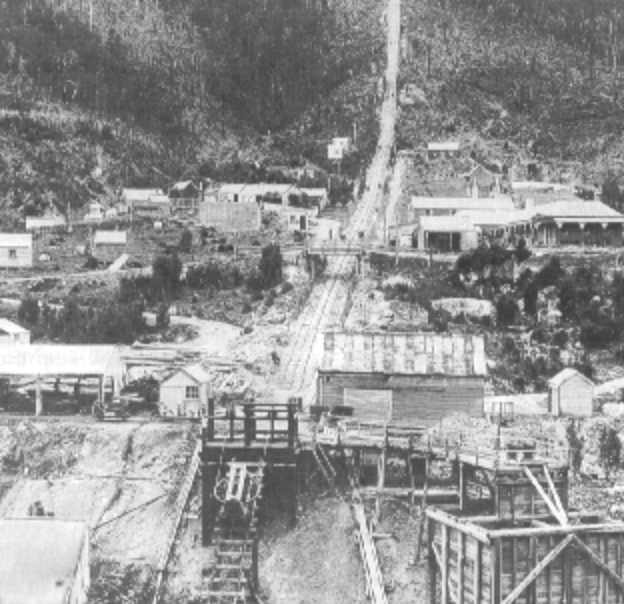
Williamsford was once a bustling and progressive community, with activities centering around mining which commenced in 1896 and continuously operating apart from several short shutdowns, till closing in 1986. There are now no residents.
The town was located on the lower slopes of the heavily timbered 3,684-foot-high Mount Read, five miles south of Rosebery, on Tasmania’s West Coast. The two towns had a close sister relationship.
In 1924, Charles Witham, the author of “Western Tasmania”, wrote
Williamsford is the township attached to Mount Read and is right at the foot of the steepest and longest haulage line we have……5 miles from Rosebery by road, and 18 miles from Zeehan by tramway, and if you like rugged and wild scenery you will find it a charming place.
In 1890, gold, copper, and zinc were discovered on Mount Read. Four years later, a large body of zinc-lead sulphide ore was located below the gold diggings, high up the western slopes of Mount Read.
At the gold mine, a settlement grew up outside the mine entrance, known as Mount Read Township, at an altitude of 3,200 feet (1,000 metres) and has the distinction of being the most elevated town that has existed in Tasmania. Williamsford was soon (1896) established at a lower level of 712 feet (217m) above sea level.
With the Williamswood population rapidly growing, the township became a bustling and progressive community and boasted having a school, Post Office, Police Station, three hotels (Terminus, Hercules, Mount Read) and three church denominations, Anglican, Catholic and Methodist. The area also supported a football team until 1963.
A challenge was moving the mined ore, firstly down the steep mountainside and then to its place of processing.
A haulage system was devised and built to cart the ore from the mine and was known as the Hercules Haulage or sometimes as the Mount Read Haulage. It consisted of a self-acting two-foot narrow gauge tramway, one mile long, descending from a height of 1642 ft with a maximum grade of 1 in 5, and travelling at a speed of 14mph. It was unique and claimed to be the largest and steepest self-acting tramway of its kind.
To reach the smelters, the ore was transferred to a tramway train, which travelled from Williamsford to Zeehan, a distance of 18 miles. The line was built by the Tasmanian Government in 1896 and was known as the North East Dundas tramway. It was a narrow gauge 2ft line and had to transit some extremely difficult terrain requiring several big trestle bridges, including one at the foot of the Montezuma Falls. After some rain the engine and carriages would get soaked by spray from the falls. The line closed in 1932.
With the tramway closing an Aerial Ropeway was built in 1931, measuring four miles in length, to cart ore to Rosebery for processing.
The Williamsford mine and ropeway operated continuously till closing in 1986, with the town going into decline and now no longer has any inhabitants.
Over the mine’s existence, production was more than 2.5 million tonnes of ore, at an estimated value of $1 Billion.
North East Dundas Tramway – Passing the Montezuma Falls
Written by Ivan Badcock – 12 April 2024

